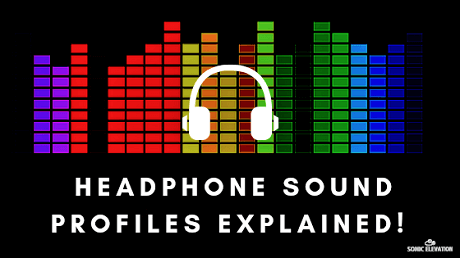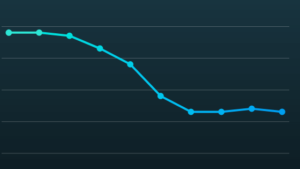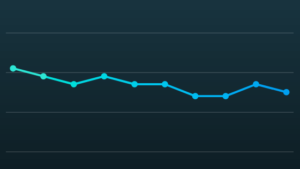
What Is A Sound Profile? – Headphone Lingo!
What is a sound profile? If you’ve ever read an in-depth and informative headphone review, you’ve probably come across this term. (‘Signature’ is interchangeable with ‘profile’ so any time we refer to ‘signature’, that’s what we mean.) There are multiple types of sound signatures and each one excels at reproducing a different style of music.
We know how overwhelming it can seem when you try to decipher what the reviewer actually means when they describe a pair of headphones using a specific signature label (especially when it’s not fully explained).
If you enjoy shopping for headphones online, it’s not always possible to try them out before you buy them. Which is another reason why it’s so important to have a general idea of what to expect before you settle on any single recommendation!
What Is A Sound Profile?
If we had to give you the most basic definition in one sentence, it would be something like this: the audio term used to describe how a specific headphone sounds, based on which frequencies are more (or less) emphasized.
Since audio is largely subjective (meaning you might prefer a different style than we do) there is no right or wrong answer. The signature you prefer almost completely depends on which genres of music you usually listen to.
It also depends on what kind of listener you are. For example, if you’re an audiophile, you’ll probably lean towards a style of playback that the average listener might not enjoy. If you have a home studio (or record professionally) your taste might also tend to vary, probably depending upon the setting.
Audio Lingo You Need To Know
If you’re not familiar with the audio lingo for the 3 main levels of a frequency response, you’ll want to take a look at the list below!
- Lows (bass or low end)
- Mids (mid-range)
- Highs (treble)
Once you start reading about each of the 8 signatures below, you’ll see why it’s important to know what a reviewer means when they reference lows, mids, and highs. When you see ‘lows’ or ‘low end’ – think bass.
When you see ‘mids’ or ‘mid-range’ – think vocals and/or instrumentation that sits in between super high and super low frequencies. Lastly, instruments like the violin or high-note soprano vocals represent the ‘highs’ or ‘treble’.
Remember These 7 Sound Signatures!
Now that you have some important background information, you’re ready to dive into the specific types of profiles. Read about each of the categories below to equip yourself with the knowledge you need to make the most informed decision next time you’re researching a specific headphone!
What does each one mean? How will they affect the way your music sounds? If you don’t want to be left in the dark next time you read a review keep reading below!
1. Extra Bass/Bass Boosted

Bass, more bass, and a little extra bass… just in case there wasn’t already enough to satisfy most bass heads needs. This one is exactly what you probably thought when you read it. The low end is the obvious focus here while the mids and highs are both dialed back.
Companies like V Moda and Beats make some pretty heavily bass-boosted headphones that are so strong, they can make your skull literally vibrate at higher volumes. They’re usually loud and aggressive, which sometimes results in a slight loss of detail.
If the bass is so powerful that you can’t hear anything other than the loud thump, your music can start to sound ‘muddy’. This is why most audiophiles tend to steer clear of extremely bass-heavy cans.
Best genres to listen to with this type:
- EDM
- Hip-Hop/Rap
- House
- Ambient
- Pop
Keep scrolling to see what a v-shaped signature looks like!
2. V-Shaped

V-shaped headphones are similar to bass boosted, except they have a strong bass (low end) with a laid back mid-range and sparkling highs (treble). They’re usually described as sounding extremely ‘exciting’ or ‘engaging’.
Brands like Beats, V Moda, and Sony are well-known for making v-shaped headphones. Since the lows and highs are both elevated, most music you listen to will sound much louder and more crisp. Certain headphones do have a tendency to become so crisp that the treble can sound piercing, which is the main downside of this signature.
If you like listening to music to get pumped up, excited, or filled with adrenaline, you’ll enjoy most v-shaped cans!
Best genres to listen to with this type:
- EDM
- Hip-Hop/Rap
- House
- Ambient
- Pop
- Rock
Keep scrolling to see what a u-shaped signature looks like!
3. U-Shaped

U-shaped cans produce a very similar response to v-shaped, except the mids aren’t quite as dramatically lowered. Their response on a graph would look more like an uppercase ‘U’, hence u-shaped.
They have a slightly more smooth (but elevated bass/treble), as opposed to the sharp mid range drop off that creates a v-shaped signature. The mid range should be a bit more prominent on u-shaped cans. The 1More Triple Driver in-ears are a great example of a u-shaped signature.
Best genres to listen to with this type:
- EDM
- Hip-Hop/Rap
- Electronic
- House
- Ambient
- Pop
- Rock
Keep scrolling to see what a flat/neutral signature looks like!
4. Flat/Neutral

This is usually one of the most misleading signatures out of the bunch. When we think of flat soda, it’s usually not a good thing. Your favorite soda just doesn’t taste the same when the fizz stops bubbling inside your cup. (Luckily that isn’t the case when it comes to headphones.)
Flat or neutral cans don’t necessarily sound ‘boring’ or ‘dull’ at all. In fact, they can produce a different kind of excitement that others can’t. If you were looking at a frequency graph, a neutral response looks more like a flat line.
The lows, mids, and highs are more well-balanced, which is one reason many audiophiles and audio professionals strongly prefer a neutral response over v-shaped. A flat signature is designed to sound more natural since it allows you to hear every single frequency in great detail. Most of the open back headphones here produce the flat and neutral signature that audiophiles and professionals love!
Best genres to listen to with this type:
- Any genre you prefer!
Keep scrolling to see what a bright signature looks like!
5. Bright

Bright headphones are less common since our ears are more sensitive to higher frequencies. Their elevated upper mid range and top-heavy treble tend to cause ear fatigue during longer listening sessions.
There is far less emphasis on the bass and headphones like the Grado SR325e were specifically designed to sound very bright. Often times, a bright signature contributes to a forward-sounding (although not overly aggressive) response.
Since our ear size, shape, and sensitivities do vary from person to person – only a select few tend to favor a bright signature. Grado and Beyerdynamic are two of the most popular brands that are well-known for producing brighter cans.
Best genres to listen to with this type:
- Rock
- Metal
- Jazz
- Acoustic
Keep scrolling to see what a balanced signature looks like!
6. Balanced

Is balanced the same thing as flat or neutral? While they do share a few similarities, they’re not completely interchangeable. When you compared a balanced vs. flat headphone, all 3 levels are slightly more elevated on the balanced pair.
Their sound signature places them on the spectrum somewhere between bright and bass heavy cans. The highs aren’t too sharp and the bass doesn’t overpower the mid range. Brands like Sennheiser, Audio Technica, Monoprice, and Philips make some of the best balanced cans.
As far as a specific model we’d recommend, the Monoprice M1060 use planar magnetic drivers to produce well-balanced, audiophile-level sound quality. If you already know you don’t prefer completely neutral cans, you’d probably really enjoy trying a pair of balanced headphones!
Best genres to listen to with this type:
- Any genre you prefer!
Keep scrolling to see what a warm signature looks like!
7. Warm

A warm signature features a heavy low end (bass) with prominent mids and noticeably recessed highs. Although that explanation might seem somewhat similar to bass boosted, the slightly boosted mid range is the main difference between the two.
The treble is noticeably weaker and laid back, which is why you probably want to avoid warm headphones if you’re a fan of metal, rock, or acoustic music. Their elevated low end combined with a slight mid range bump creates a comfortable and smooth tonal quality.
If you prefer a little extra bass and don’t want to sacrifice vocals in the mid range, you’d probably enjoy some warm cans. The Audio Technica ATH M60x (an on-ear from their M series line) are a great example since they have a smooth, extended low end and completely immersive sound signature.
Best genres to listen to with this type:
- Hip-Hop/Rap
- EDM
- Trap
- Pop
- House
- Ambient
Which Signature Do You Prefer?
In the world of personal audio, there are tons of technical terms and definitions. When you’re unsure about the technical jargon being tossed around when you’re reading a review, it can be overwhelming enough to give anyone a real headache.
Now that you know a little bit more on the subject, do you prefer one signature over the other? Do you enjoy exciting and aggressive playback, or a laid-back and neutral response?
Hopefully this helped clear up any confusion you had before stopping by! Now that you’re armed with some new audio knowledge to add to your Rolodex, you won’t have to wonder about what a sound profile is and why it makes such a big difference!
If you want to leave a comment, or have a question about anything you just read, feel free to leave your thoughts below! We respond to every single comment (usually within 24 hours) and look forward to hearing from you! Thanks for stopping by, we hope you enjoyed!
- Korg B2 vs Roland FP10 | Which One To Buy - May 13, 2021
- How Does Music Affect The Brain? – Let’s Find Out! - April 6, 2021
- Why Are My Headphones Crackling? – How To Fix It - April 3, 2021